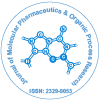Exploration of Synthetic Drugs: Development, Applications, and Societal Impact
Received: 01-Jan-2024 / Manuscript No. JMPOPR-25-163127 / Editor assigned: 03-Jan-2024 / PreQC No. JMPOPR-25-163127(PQ) / Reviewed: 17-Jan-2024 / QC No. JMPOPR-25-163127 / Revised: 22-Jan-2024 / Manuscript No. JMPOPR-25-163127(R) / Published Date: 29-Jan-2024
Abstract
Synthetic drugs, chemically engineered substances designed to mimic the effects of natural drugs or create entirely new pharmacological effects, have become increasingly prevalent in modern medicine and recreational use. This article explores the various categories of synthetic drugs, their mechanisms of action, therapeutic applications, and the challenges they pose, including potential for abuse and public health concerns. As the landscape of synthetic drug development continues to evolve, understanding their implications is crucial for healthcare professionals, policymakers, and society at large.
Keywords
Synthetic drugs; Pharmacology; Drug development; Therapeutic applications; Public health; Substance abuse
Introduction
The development of synthetic drugs has revolutionized the field of medicine, providing new treatment options for a variety of conditions. Unlike natural drugs derived from plants or animals, synthetic drugs are created through chemical processes, allowing for greater control over their properties and effects. While many synthetic drugs have proven beneficial in clinical settings, others have emerged as substances of abuse, leading to significant public health challenges. This article aims to provide a comprehensive overview of synthetic drugs, examining their classifications, mechanisms, therapeutic uses, and the associated risks [1,2].
Description
Classification of synthetic drugs
Synthetic drugs can be broadly classified into several categories based on their chemical structure and intended use:
Pharmaceuticals: These are synthetic drugs developed for therapeutic purposes. Examples include:
Antidepressants: Such as selective serotonin reuptake inhibitors (SSRIs) like fluoxetine.
Antipsychotics: Such as risperidone and olanzapine [3,4].
Analgesics: Such as synthetic opioids like fentanyl.
Recreational drugs: These are synthetic substances designed to mimic the effects of illicit drugs. Examples include:
Synthetic cannabinoids: Often referred to as "Spice" or "K2," these compounds are designed to mimic THC, the active ingredient in cannabis.
Synthetic stimulants: Known as "bath salts," these drugs can produce effects similar to amphetamines or cocaine [5,6].
Research chemicals: These are newly developed synthetic compounds that are often not yet fully understood in terms of their effects and safety profiles. They are frequently sold online and can pose significant risks to users.
Mechanisms of action
The mechanisms of action of synthetic drugs vary widely depending on their chemical structure and target receptors in the body. For example:
Opioids: Synthetic opioids like fentanyl bind to opioid receptors in the brain, producing analgesic effects but also carrying a high risk of respiratory depression and overdose [7].
Stimulants: Synthetic stimulants may increase the release of neurotransmitters like dopamine and norepinephrine, leading to heightened alertness and euphoria, but also increasing the risk of cardiovascular complications.
Cannabinoids: Synthetic cannabinoids interact with the endocannabinoid system, often producing effects that can be more potent and unpredictable than natural cannabis.
Discussion
The rise of synthetic drugs has brought both advancements and challenges. On one hand, synthetic pharmaceuticals have led to significant improvements in the treatment of various medical conditions, offering targeted therapies that can enhance patient outcomes. For instance, synthetic opioids are invaluable in managing severe pain, while synthetic antidepressants have transformed the treatment landscape for mental health disorders. On the other hand, the emergence of synthetic recreational drugs has raised serious public health concerns. Many of these substances are unregulated and can have unpredictable effects, leading to increased rates of addiction, overdose, and other health complications. The rapid development of new synthetic drugs often outpaces regulatory efforts, making it difficult for authorities to keep up with emerging threats [8,9].
Moreover, the stigma associated with synthetic drug use, particularly in the context of recreational substances, complicates public health responses. Education and harm reduction strategies are essential to address the risks associated with synthetic drugs, emphasizing the importance of informed decision-making and access to treatment for those struggling with substance use disorders [10].
Conclusion
Synthetic drugs represent a complex and evolving landscape in both medicine and society. While they offer significant therapeutic benefits, particularly in the treatment of chronic pain, mental health disorders, and other medical conditions, they also pose substantial risks, especially in the realm of recreational use. As the development of synthetic drugs continues to advance, it is crucial for healthcare professionals, policymakers, and the public to remain informed about their implications. A balanced approach that prioritizes research, regulation, and education will be essential in maximizing the benefits of synthetic drugs while minimizing their potential harms.
Acknowledgement
None
Conflict of Interest
None
Citation: David M (2025) Exploration of Synthetic Drugs: Development,Applications, and Societal Impact. J Mol Pharm Org Process Res 13: 264.
Copyright: 穢 2025 David M. This is an open-access article distributed under theterms of the Creative Commons Attribution License, which permits unrestricteduse, distribution, and reproduction in any medium, provided the original author andsource are credited.
Select your language of interest to view the total content in your interested language
Share This Article
Recommended Journals
91勛圖 Journals
Article Usage
- Total views: 107
- [From(publication date): 0-0 - Sep 03, 2025]
- Breakdown by view type
- HTML page views: 82
- PDF downloads: 25
